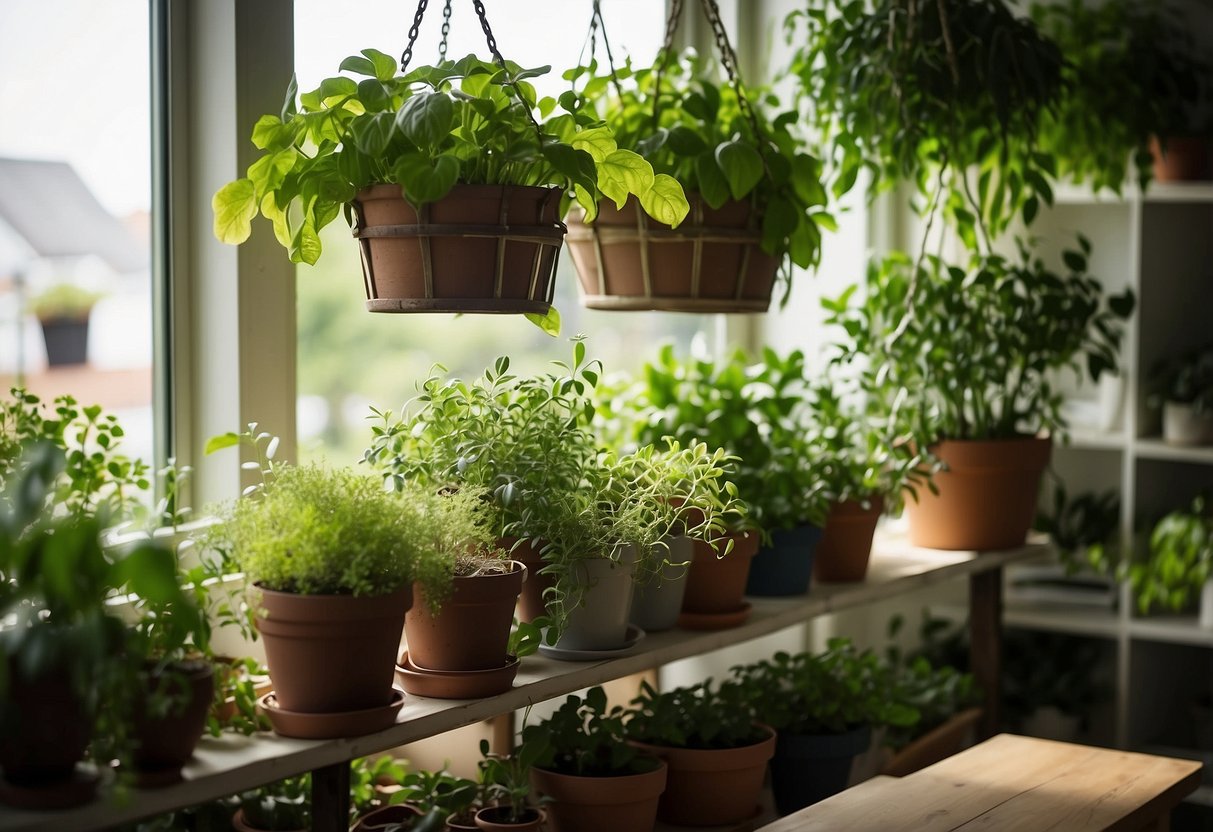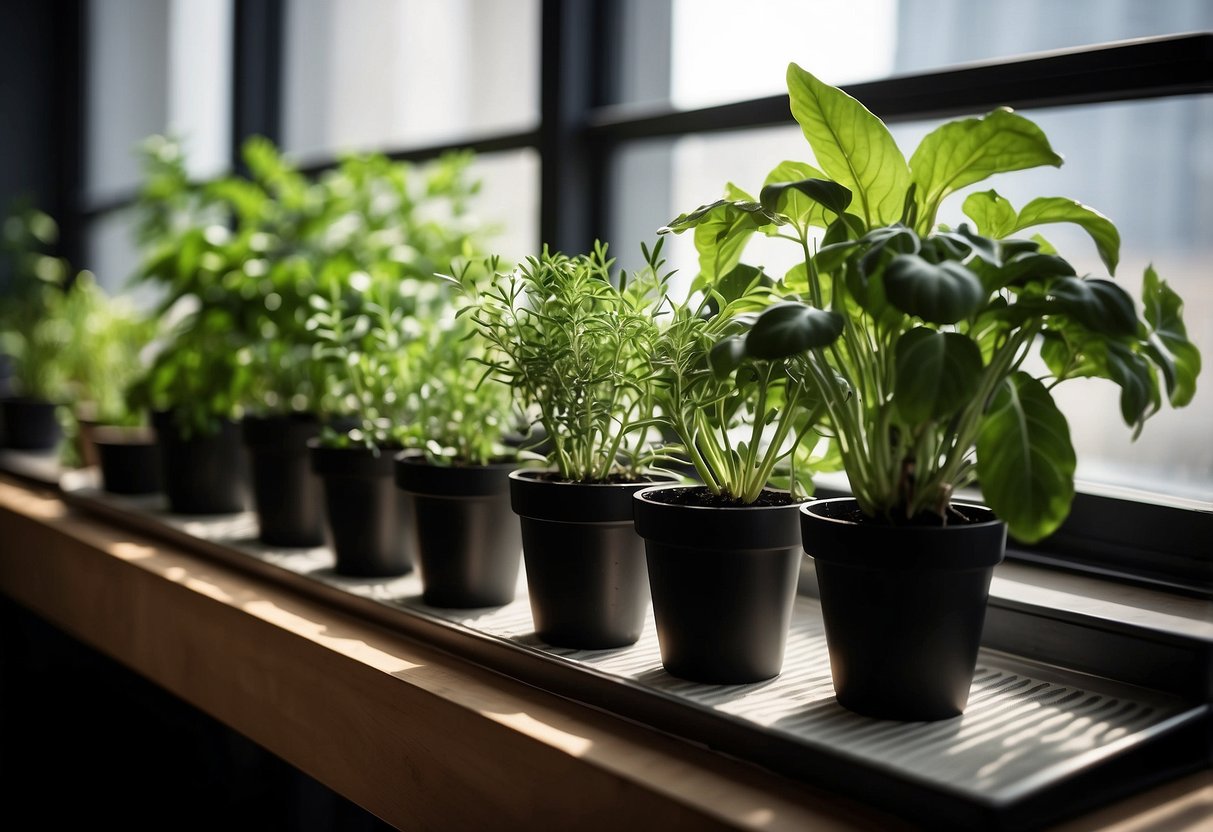Indoor Edible Garden Ideas: Transform Your Home with Fresh Herbs and Veggies
Creating an indoor edible garden can be a rewarding project that brings fresh produce right into your home. By growing vegetables and fruits indoors, you can enjoy healthy, homegrown food year-round, regardless of the weather outside.

Imagine having fresh herbs, leafy greens, or even strawberries just a few steps away from your kitchen. With a bit of planning and effort, your indoor space can transform into a lush, productive garden. Whether you have a sunny windowsill or a more advanced setup with grow lights, there are plenty of options to explore.
1) Basil on Your Windowsill

Basil is a fantastic herb to grow on your windowsill. It thrives in sunlight, so find a sunny spot for it.
Use fresh potting soil up to 1 inch from the rim of your container. Plant a few seeds or seedlings, then cover lightly with soil and water well.
For best results, use an organic fertilizer during the growing season. This will keep your basil healthy and flavorful. HotKey for great tips check here.
With these simple steps, you’ll have fresh basil at your fingertips year-round.
2) Hydroponic Lettuce Setup

Growing hydroponic lettuce at home is simple and fun. Start with the Kratky method, which needs no pumps or electricity. It’s cheap and easy to set up.
Lettuce grows fast and needs less light than other crops. Keep your grow light panels at least eight inches from the plants for the best results.
Maintain an optimum temperature between 60°F (15°C) and 70°F (21°C). Adjust temperatures during different growth stages for better yield. Enjoy fresh, crisp lettuce year-round!
3) Indoor Meyer Lemon Tree

Growing a Meyer lemon tree indoors is a fun and fruitful project. These trees are compact and can produce plenty of lemons even in a small space.
Place your tree near a south-facing window for lots of sunlight. If needed, use an LED grow light to provide about 12 hours of light each day.
Water your tree when the top inch of soil feels dry. Make sure the pot has drainage holes to prevent overwatering. Use well-draining soil and fertilize with citrus-specific food every 6-8 weeks for the best results.
4) Microgreens Tray

Growing microgreens is a great way to add fresh greens to your meals. They are easy to grow and don’t take up much space.
To start, get a shallow tray. Fill it with soil and sprinkle the seeds evenly. Pat the soil gently.
Water the seeds until the soil is damp. Place the tray in sunlight or under grow lights. Mist with water a few times a day.
Your microgreens should sprout in about 10-12 days. Enjoy adding them to salads, sandwiches, or as a garnish. For more details, check out this guide on growing microgreens indoors.
5) Hanging Strawberry Baskets

Hanging strawberry baskets are a fun way to grow your own fruit indoors. They don’t take up much space and are easy to care for. You’ll need a sturdy basket about 10-16 inches wide.
Make sure the soil is deep enough for the roots, around six inches. Fill the basket with soil, leaving room for the plants to grow. Water regularly but avoid soggy soil.
Place your hanging basket in a sunny spot. Strawberries love sunlight. Fertilize the plants weekly to keep them healthy and productive. Enjoy picking fresh strawberries from your living room!
Learn more with tips from Epic Gardening.
6) Tower Garden for Herbs

Using a tower garden for herbs is a smart way to grow fresh, tasty plants indoors.
Herbs like basil, cilantro, and thyme thrive well in this system. You can grow anywhere from 20-32 plants at once, making it perfect for those who love cooking with fresh ingredients.
There’s no need for soil, so it’s clean and easy to maintain. Plus, you’ll enjoy the aromatic benefits of herbs right in your home. It’s a fun, eco-friendly project for any herb enthusiast.
7) Potted Mini Cherry Tomatoes

Growing mini cherry tomatoes in pots is a fun way to enjoy fresh tomatoes at home. These little plants are perfect for small spaces and patios. You only need one cherry tomato plant per 12 to 14-inch pot.
Make sure the pot gets at least six hours of sunlight daily. Eight or more hours is even better for a healthy plant.
Check the soil before watering to avoid root rot. Use a gentle spray or insecticidal soap to clear pests off the foliage. Happy planting!
8) Indoor Mushroom Kit

An indoor mushroom kit is a great way to grow fresh mushrooms at home.
These kits usually come with everything you need, like a substrate and spores. You just need to keep it in a dark, moist place, and monitor the temperature.
Mushrooms such as oyster mushrooms are popular choices since they thrive in high humidity and cooler temperatures.
Watching your mushrooms grow can be a fun and rewarding experience!
9) Avocado plant from seed

Growing an avocado plant from a seed is super simple. First, remove and clean the pit from an avocado. Be sure to wash off any fruit flesh.
Next, insert three toothpicks around the middle of the seed. Balance the seed over a glass of water with the flat side down. Place it in a sunny spot and wait for it to sprout.
Once the roots are thick and the stem has new leaves, transfer the seed to a pot. Make sure the pot is about 10 inches in diameter and keep half the seed exposed above the soil.
Keep the soil moist and watch your avocado plant grow! If you need more guidance, you can check out these tips for growing avocados indoors. Enjoy your home-grown avocado!
10) Kitchen Herb Garden

Creating a kitchen herb garden is a fantastic way to keep fresh herbs within reach while cooking. Herbs like mint, parsley, and basil thrive indoors.
You can start by planting these herbs in water. This avoids the mess of soil and makes upkeep simple. Another idea is to use window boxes on a south-facing window for ample sunlight.
For easy maintenance, make sure to use well-draining potting mix and water your herbs regularly. It’s also helpful to choose herbs that do well indoors, such as lemon balm and chives.
Getting Started

Creating an indoor edible garden is a rewarding experience. Let’s look at how to choose the right space and gather the essential tools and materials you’ll need.
Choosing the Right Space
The first step is finding the perfect spot. Natural light is crucial, so look for areas with plenty of sunlight, like a south-facing window. If your home lacks natural light, you can use grow lights. These mimic sunlight and help plants thrive.
Temperature matters, too. Keep the garden in a place with stable temperatures, ideally between 60°F to 70°F. Avoid drafty spots or areas too close to heating vents, as sudden temperature changes can harm plants.
Consider air circulation. Good ventilation prevents mold and helps plants grow healthier. If needed, use a small fan to keep the air moving.
Make sure there’s enough room for your plants to grow. Whether you opt for shelves, tables, or hanging gardens, ensure the space can accommodate the varying sizes of plants.
Essential Tools and Materials
Start with quality potting mix. A good mix contains nutrients and provides proper drainage, preventing root rot. For seeds, use pots or trays filled with pre-moistened mix, and be mindful of spacing based on the type of plants you’re growing.
You’ll also need watering tools. A spray bottle works for small seedlings, while a watering can is better for larger pots. Consider a humidity tray to maintain moisture levels.
Fertilizers are key for plant health. Choose an appropriate fertilizer based on your plant types. For instance, leafy greens benefit from nitrogen-rich formulas.
Don’t forget about grow lights if natural light is limited. LED grow lights are energy-efficient and effective.
Lastly, having basic gardening tools like a small trowel, pruners, and labels will make your gardening tasks easier and more organized.
Soil and Containers

To grow a successful indoor edible garden, selecting the right soil and containers is crucial. The right combination ensures that your plants thrive indoors.
Selecting the Best Soil
Choosing the correct soil is important for healthy plant growth. Organic potting mix is recommended because it provides good drainage. This type of soil is light and allows roots to breathe while holding enough moisture.
Avoid using garden soil from outside. It can carry pests or diseases that disrupt your indoor garden. Look for soil that is rich in nutrients and has been sterilized to kill any unwanted organisms. Including perlite or vermiculite can improve soil aeration.
Regularly check the soil’s moisture by touching it. Keeping it evenly moist—not too wet or too dry—is key for most indoor plants.
Types of Containers
The type of container you use impacts plant health. Clay pots are common because they allow air to reach the plant roots. Plastic containers are lighter and easier to move, but they may retain more water, so ensure they have drainage holes.
For veggies like tomatoes and broccoli, pots should be at least 12 inches deep, as they have larger root systems. On the other hand, lettuce and herbs can thrive in window boxes or shallow containers, which can be as deep as 6-8 inches.
Placement of the containers also matters—ensure they get enough light but avoid areas with extreme temperature fluctuations.
By carefully selecting soil and containers, your indoor garden will be well on its way to producing fresh, healthy vegetables right at home.







